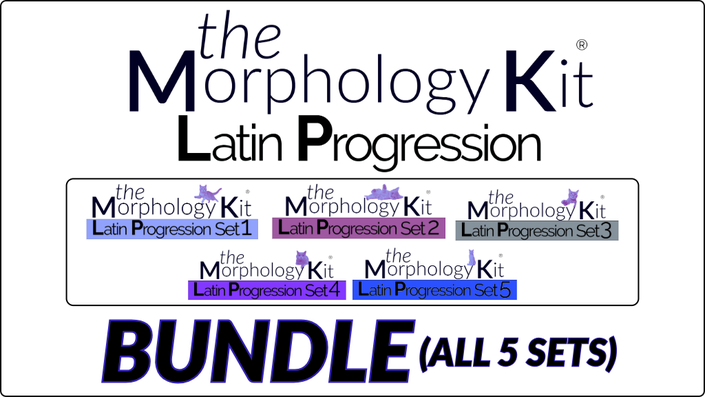

High-frequency morphemes
After third grade, over 60% of the words we encounter in school include Latin morphemes. Students say, read, and spell words with them every day!
By learning these high-frequency morphemes, your students will find it easier to read and spell longer words.
And, since each morpheme carries meaning, your student's vocabulary will grow as well!
Product Details
The Morphology Kit® Latin Progression moves through a progression of Morpheme Lessons that build on one another with embedded review.
Digital game versions of the activities (with the exception of word chains) are also available.
PowerPoint and PDF files (or, just PDF files in the PDF-only version).
Instructor Guide and Answer Keys included.

Set Contents
Each Set contains 10 Morpheme Lessons, each of which focuses on a single Latin morpheme, such as the base element, "PORT."
Provided in both PowerPoint and PDF files (or, just PDF files in the PDF-only version).
Digital game versions of the activities (with the exception of word chains) are also available.
Morpheme Lessons
Each Morpheme Lesson includes a range of activities in 2 main sections, Core Lesson and Activities, designed to support the development of key language processes in addition to morphology, such as orthography (how words are written), semantics (how words make meaning), and syntax (how words work together in sentences, etc).
During her presentation at the IDA conference, DyslexiaCon24, Dr. Wolf stated, "The more you know about a word, the faster you will read and comprehend words and stories."
1. Core Lesson
The Core Lesson (instructor-led) teaches students the fundamental elements of each morpheme, while giving them plenty of opportunity to apply their knowledge.
Instead of just memorizing the sense of meaning for each morpheme, students learn to see how that morpheme works in words.
Every core lesson builds on prior knowledge by reviewing known morphemes, introducing a new one, and guiding students through word sums and matrices.

2. Activities
A set of Activities that can be done together in your shared learning environment or as independent activities to supplement instruction and reinforce learning.
Each activity set in Latin Progression includes some of the following activities:
- spoken and spelling word chains
- segmenting (breaking words into their individual morphemes)
- word building (creating words from their individual morphemes)
- sorting words (based on sound, spelling, meaning, or parts of speech)
- matching exercises (matching words to related words, matching words to their definitions, or matching assimilated prefixes to the rest of the words)
- tasks centered on word families (students find related words, sort related words into parts of speech categories, and use them in sentences)
- unscrambling morphemes to form words
- connected text (fill in the missing words in sentences and paragraphs)




